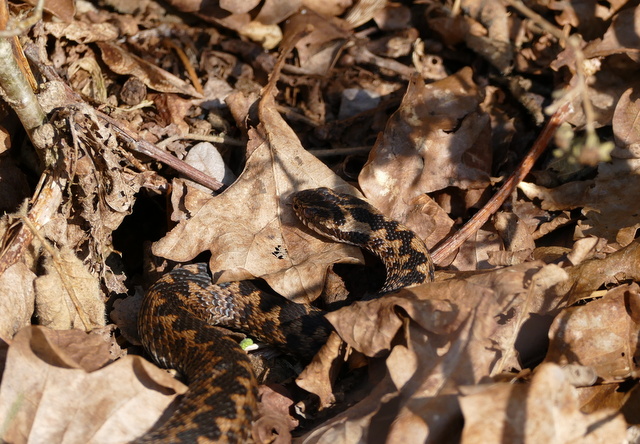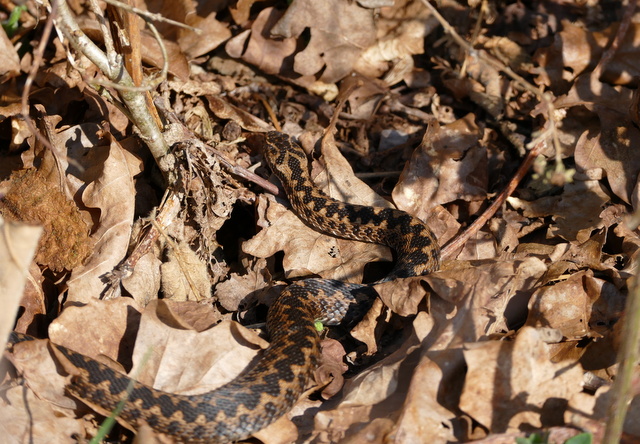A Private Tour, based around the Cley area in North Norfolk. It was to be a leisurely day of general birding today, looking mostly at the wide variety of birds found here.
It was a glorious sunny start to the morning, after the overnight frost had melted. A perfect day for the heath. A Bullfinch was calling from the bushes and we found it perched up feeding on buds, a smart male. We started out with a quick look for Adders – and it didn’t take long for us to find them. It was a great morning for them to bask in the sun after a cold night. Some were already warmed up and more active; they slithered away as we approached. Others were more sluggish and remained curled up amongst the leaves, some in little knots of several together.
It was beautiful up on the heath. The Common Gorse was in flower and looking fantastic in the sunshine. It didn’t take long to find the Dartford Warblers either. We could hear a male singing and see it flitting around in the gorse, but it was a bit distant. We walked round to the other path and quickly found it again, much closer now. We watched it on and off for a while, singing intermittently and calling.
Then a second bird shot across between two bushes a short distance away – although we initially thought it must be a female, the next time it flew another Dartford Warbler was with it. The first male was still singing away to our left, and then the second male hopped up to the top of the heather and started to sing too – a territorial boundary was being marked out!
We spent some time in the trees. A Chiffchaff was darting around and calling. We stopped to watch a little group of Goldcrests, admiring their golden crown stripes. The Coal Tits were singing from the pines. A Greenfinch was also performing. A little group of Linnets flew overhead and out on the heath we paused to admire one singing from the top of some bushes.
A dry rattling song ahead alerted us to the presence of yet another Dartford Warbler. We watched it perched in the top of the gorse singing. A perfect morning for the Dartford Warblers today, with the sunshine.
 Dartford Warbler – no photos from today, so here’s one from last week
Dartford Warbler – no photos from today, so here’s one from last week
We could easily have spent the whole day roaming round the heath in the sunshine, but we wanted to explore some other places today, so we headed down to the coast at Weybourne. A pair of Garganey have been hanging around on a small pool by the beach for a few days now, but there was no sign of them initially, when we arrived. Only when some people walked down to the edge of the pool, did everything flush from the water and the male flew out and landed in full view. We got it in the scope briefly but it quickly swam into the far corner, out of view again.
Walking round to the other side, we found an angle from where we could see that edge of the pool much better. It wasn’t long before both the male and the female Garganey swam out and started to feed along the edge of the reeds. Such a smart little duck (& drake!).
 Garganey – this pair was on a pool by the beach at Weybourne
Garganey – this pair was on a pool by the beach at Weybourne
While we were there, a steady stream of Meadow Pipits was passing overhead, in ones and twos and small flocks. There were a few Pied Wagtails moving west as well, though with some passing by overhead it was impossible to be sure that there weren’t any of their continental European brethren, White Wagtails, in amongst them. It was good to see – migration in action.
 Pied Wagtail – small numbers were on the move along the coast today
Pied Wagtail – small numbers were on the move along the coast today
A Chiffchaff was singing from the bushes in the reedbed and, when we stopped to look for it, a second one appeared with it. We could also hear a Goldcrest calling from the same place. It seemed like they were all most likely on their way somewhere as well, just stopping off here to feed on all the insects around the edge of the reeds. A male Reed Bunting which perched up for us was more likely one of the residents.
From there, we drove on to Cley. We stopped for an early lunch and it was even nice enough to eat outside on one of the picnic tables in front of the visitor centre! While we were eating, we could hear a Marsh Harrier calling high overhead and we picked it up skydancing, before tumbling back down and dropping into the reedbed. Spring is in the air.
On the walk out onto the reserve, we stopped to look at a male Stonechat on the brambles by the road. Stonechats have been on the move for the last week or so and, although this may have been a lingering winter bird or even possibly one of the few that might stay to breed locally, perhaps more likely it will juts be pausing on its way back north.
Plenty of display activity was also underway on the reserve. A pair of Lapwings were displaying by the path on Cricket Marsh. The male was bowing deeply, in front of the female, showing off his orangey undertail. The female did not look impressed! Another Lapwing flew overhead and the male took off and flew round ‘singing’, giving a quick rolling display flight before landing back next to her and bowing again. She responded by flying off. We were more impressed – displaying Lapwings are one of the real sights and sounds of spring on the marshes.
Out on Pat’s Pool, there were lots of Avocets and they have all started to sort themselves into pairs. There was lots of displaying going on amongst them, too, walking around together and bowing to each other. We watched others feeding, sweeping their upturned bills from side-to-side through the water.
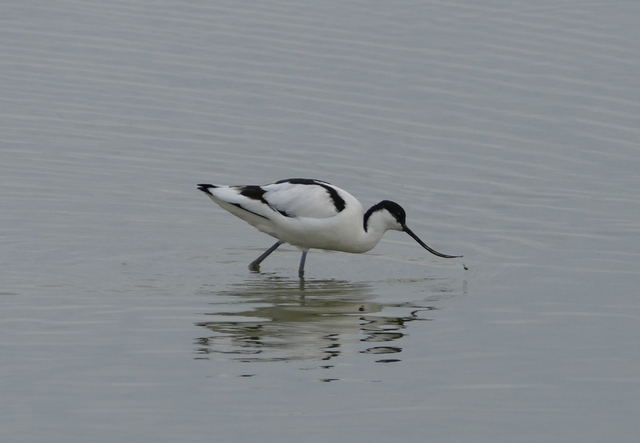 Avocet – we watched some feeding…
Avocet – we watched some feeding…
There were other waders to look at as well. Amongst the Black-tailed Godwits, several were now looking very orange, as they moult into breeding plumage. We admired the variety of Ruff, including one very white-headed male. A little group of Dunlin fed in the shallows and several Redshank flew around calling loudly. There were ducks, too. Lots of Teal and Gadwall, several Shelduck, Mallard and a little flock of Wigeon grazing on one of the banks.
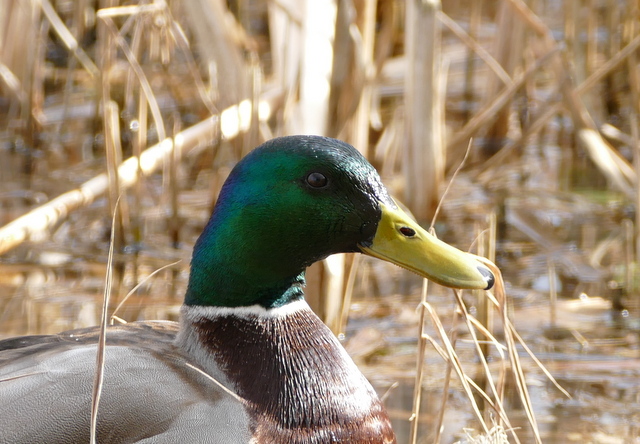 Mallard – all the male ducks are looking at their best now, even the Mallard
Mallard – all the male ducks are looking at their best now, even the Mallard
However, the highlight was the Water Rail which was feeding in front of one of the hides. We saw it from one hide, in front of the other, so walked round there to get a closer look. When we got there, it was hiding in the reeds. We sat and waited for a few minutes, but it remained out of view – we could just see bits of it through the vegetation. Only when we had gone to look out of the other side of the hide did the Water Rail come out and feed in full view again. At least we got back over to see it before it ran back in again.
 Water Rail – in front of one of the hides today
Water Rail – in front of one of the hides today
By now it had clouded over and cooled down, but that didn’t stop us from walking round to the East Bank. A Curlew fed quietly in the wet grazing marshes by the path. The Marsh Harriers were still over the reeds and a couple of Common Buzzards flew west the other side of the road. A Grey Heron flew over and dropped into the trees, calling. A Little Egret was feeding on the Serpentine.
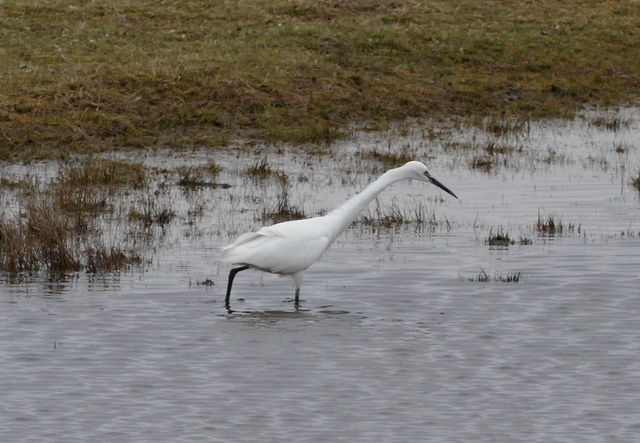 Little Egret – feeding by the East Bank
Little Egret – feeding by the East Bank
We added a couple more ducks to the days list. There were plenty of Shoveler and when we finally found one with its head not under the water, we had a good look at its enormous bill. A cracking drake Pintail was up-ending in one of the deeper pools, which gave us a great view of its long pin-tail. There were also lots of Brent Geese still feeding out on the grass. Surely they should be heading off soon too, on their way back to Russia.
There were more waders as well. We stopped to watch a Snipe feeding alongside one of the channels. It was so well camouflaged, it was tricky at times to see even through the scope as it lurked amongst the grassy tussocks. Out on Arnold’s Marsh, we found a Grey Plover, still mostly grey with white spangles but starting to get a little black around the face, the start of its moult into summer plumage. While we were watching it, a Ringed Plover ran into view in front of it.
Then it was time to walk back. We stopped briefly to admire a pair of Goldfinches in the bushes opposite the car park and a Cetti’s Warbler sang loudly from the brambles nearby, bidding us farewell.
